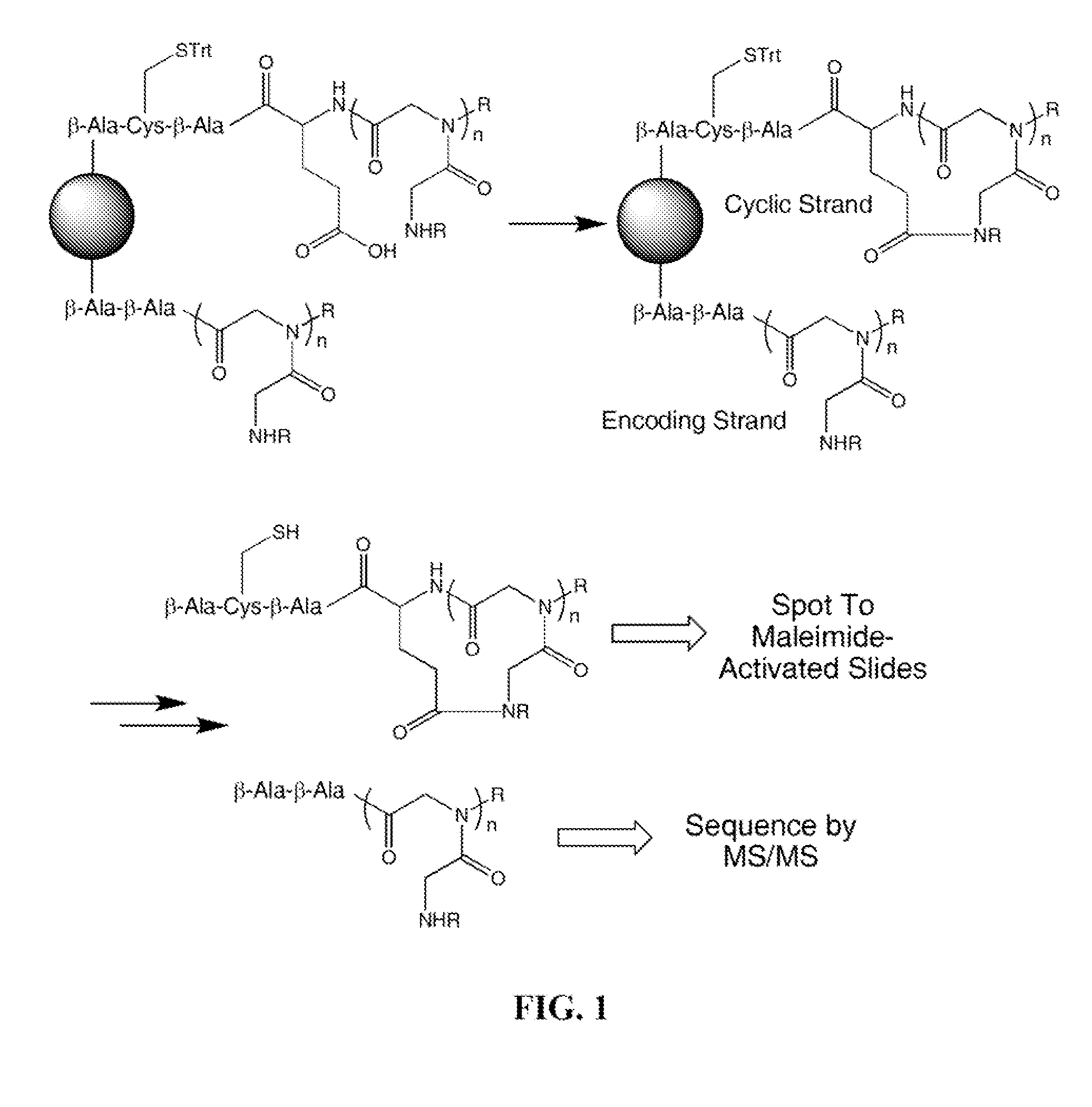Antigen surrogates in autoimmune disease
a technology of autoimmune diseases and surrogates, applied in the field of molecular biology, immunology and medicine, can solve the problems of no highly reliable serum protein marker for diagnosis of most autoimmune diseases, significant undesirable side effects, and the state of the art in the development of diagnostic agents and effective therapies for autoimmune diseases
- Summary
- Abstract
- Description
- Claims
- Application Information
AI Technical Summary
Benefits of technology
Problems solved by technology
Method used
Image
Examples
example 1
Methods
[0364]Peptoid Library Synthesis
[0365]Details regarding design of the peptoid library have been published previously (Udugamasooriya et al., 2008). Briefly, the library is synthesized on TentaGel macrobeads (140-170 μM diameter; substitution: 0.48 mmol / g resin; Rapp Polymere). Synthesis of the library is conducted using eight different amines resulting in a theoretical diversity of 262,144 compounds. A 9-mer library is synthesized using a microwave (1000 W)-assisted synthesis protocol and a split and pool method (Olivos et al., 2002). At the completion of library synthesis, beads are treated with a 95% TFA, 2.5% triisopropylsilane, and 2.5% water mixture for 2 hours to remove side chain protection groups and then neutralized with 10% diidoproplyethylamine in DMF. The beads are washed with dichloromethane, dried, and stored at 4° C. until use.
[0366]Resynthesis of Soluble Peptoids.
[0367]Resynthesis of peptoid ligands and scrambled control peptoids is conducted on Knorr amide MBH...
example 2
A Screen for Specific Autoreactive T Cell Ligands in EAE
[0381]For purposes of combination therapy using the antigen surrogates of formula I and using T-cell ligands, the following experimental is provided. The Multiple Sclerosis (MS) (Noseworthy et al., 2000)-like condition of EAE is induced in genetically susceptible strains of rodents by immunization with myelin proteins or peptides, or by passive transfer of myelin-specific CD4+ T cells (Zamvil and Steinman, 1990). Studies in EAE indicate that myelin-specific CD4+ T cells that have become activated in the periphery, and produce pro-inflammatory cytokines, play a major role in disease pathogenesis of MS (Zamvil and Steinman, 1990). Moreover, these T cells express T cell receptors that are believed to preferentially recognize myelin basic protein in the central nervous system of affected individuals leading to destruction of the myelin sheath and, ultimately, neurological deficit (Zamvil and Steinman, 1990). Therefore, a therapeuti...
example 3
Pemphigus Vulgaris
[0394]A library of 10,000 cyclic peptoids on an array was generated pursuant to the general methods described herein. The library is screened against labeled (or unlabeled) pemphigus autoantibody and certain ligands were found bound to the autoantibodies on the support. The autoantibodies may be obtained from, for example, sera of patients having pemphigus vulgaris (PV) using soluble recombinant extracellular domains of desmoglein 3 to obtain affinity purified anti-desmoglein 3 autoantibodies as described in Ding et al., “The Anti-Desmoglein I Autoantibodies in Pemphigus Vlugaris Sera are Pathogenic”, The Journal of Investigative Dermatology, vol 112, No. 5, pp 739-743 (1999). The bound autoantibodies associated with the particular ligands were detected and then the identity of the antigen surrogate was determined from its position on the array. The preferred cyclic peptoids which act as antigen surrogates comprise 5-mers substituted with R1-R5 wherein R1-R5 is ind...
PUM
| Property | Measurement | Unit |
|---|---|---|
| median time | aaaaa | aaaaa |
| temperatures | aaaaa | aaaaa |
| temperatures | aaaaa | aaaaa |
Abstract
Description
Claims
Application Information
 Login to View More
Login to View More - R&D
- Intellectual Property
- Life Sciences
- Materials
- Tech Scout
- Unparalleled Data Quality
- Higher Quality Content
- 60% Fewer Hallucinations
Browse by: Latest US Patents, China's latest patents, Technical Efficacy Thesaurus, Application Domain, Technology Topic, Popular Technical Reports.
© 2025 PatSnap. All rights reserved.Legal|Privacy policy|Modern Slavery Act Transparency Statement|Sitemap|About US| Contact US: help@patsnap.com



